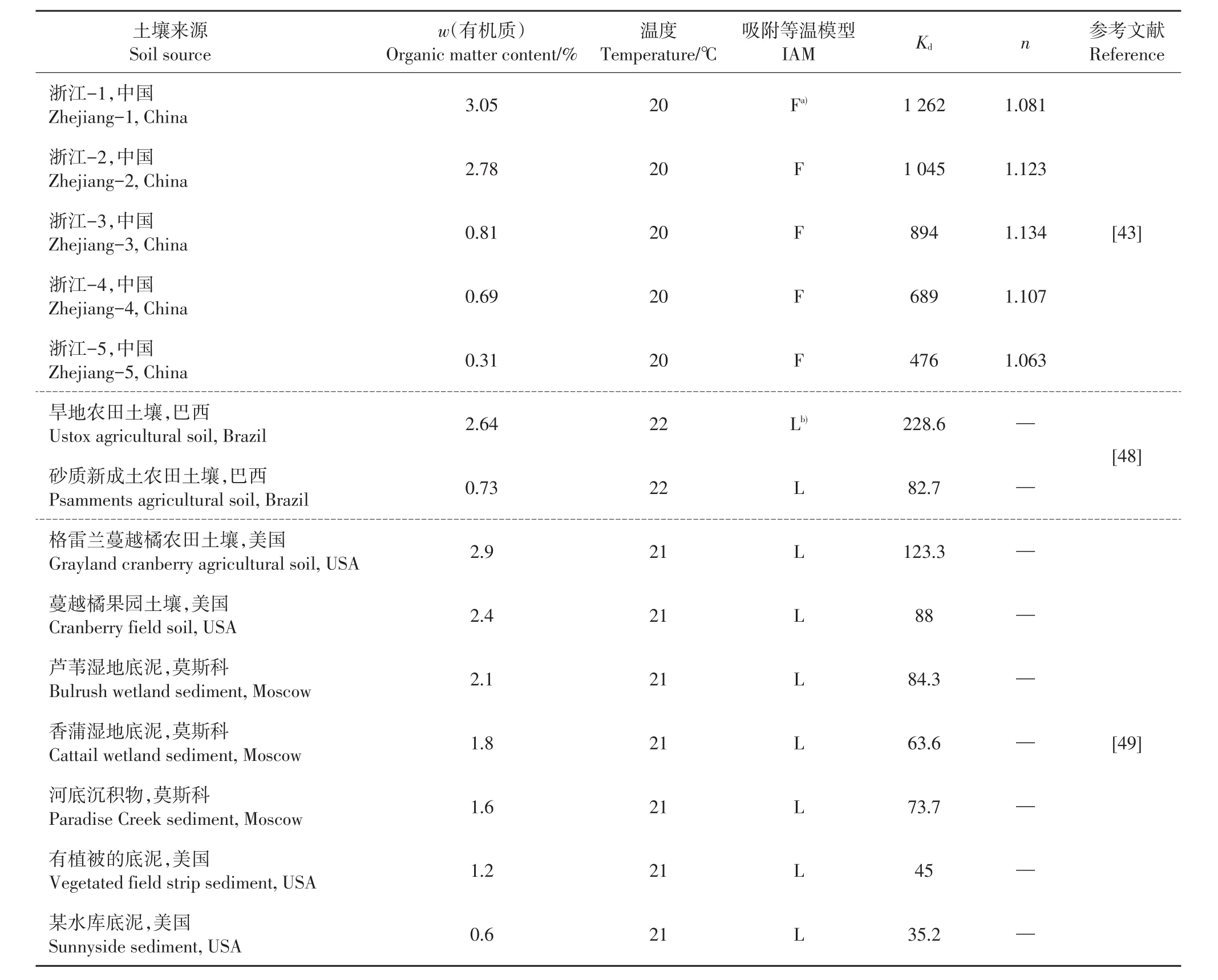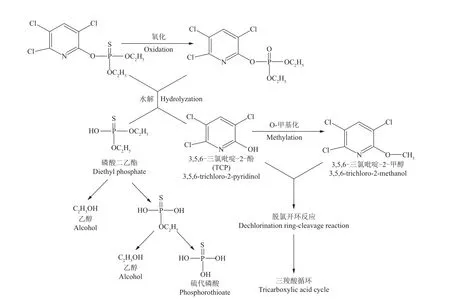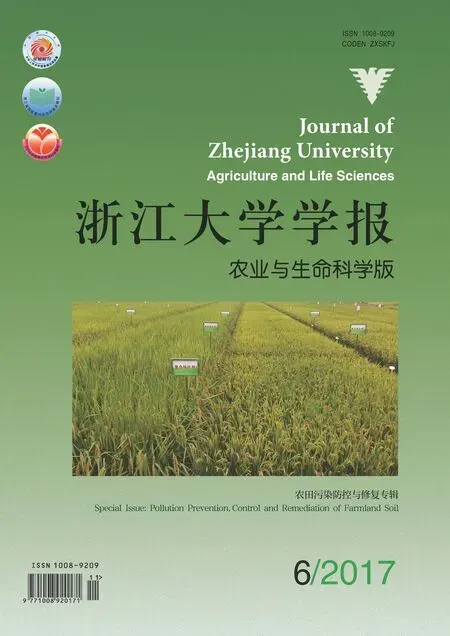毒死蜱土壤环境行为研究进展
2018-01-12薛南冬刘寒冰杨兵苏献伟王冬琦
薛南冬,刘寒冰,杨兵,苏献伟,王冬琦
毒死蜱(chlorpyrifos),化学名称O,O-二乙基-O-(3,5,6-三氯-2-吡啶基)硫代磷酸酯,是一种广谱、高效有机磷杀虫剂。毒死蜱通过抑制乙酰胆碱酯酶的活性影响神经系统,导致生物死亡[1],因此,对非靶标生物甚至人类存在潜在毒性[2-3]。调查显示,施用的毒死蜱只有不到1%能作用于靶标生物[4],大部分将进入大气、土壤、水体环境[5-8]。土壤是毒死蜱在环境中的主要归宿,毒死蜱在土壤环境中的残留可能带来潜在生态风险[9-10]。毒死蜱在土壤介质中的环境影响和环境行为日益受到关注[11-13],本文综述了毒死蜱在土壤环境中的赋存和归趋的研究进展。
1 毒死蜱在土壤环境中的赋存
近年来,毒死蜱的广泛应用,导致在许多国家和地区的土壤、河流、地下水、城市污水系统、雨水、空气等环境中均检测到其残留。在一些国家,毒死蜱是环境中残留检出频率最高的农药品种之一[14],甚至在农作物中也检测到其残留[15]。在对水稻、玉米和大豆3种农产品共计144个样品的调查中发现,毒死蜱的检出率分别为64.6%、18.8%和2.08%,在谷物类农产品中的检出率较高[16]。
曾阿莹等[17]对中国福州某蔬菜基地43个土壤样品有机磷类农药残留的检测结果显示,毒死蜱的最大残留量为9.77 mg/kg,其检出率高达97.7%。调查发现,在美洲附近的海洋沉积物[18],甚至在北极圈土壤样品中都有毒死蜱的检出[14]。
1.1 毒死蜱在土壤环境中的半衰期
在土壤环境中,毒死蜱经物理、化学和生物作用不断消解,其消解速度与土壤pH值和环境温度有关[19-20]。在碱性土壤中,温度越低,毒死蜱半衰期越长;在同一温度下,碱性土壤中毒死蜱半衰期较短,说明碱性土壤可能有利于毒死蜱的降解[21]。在不同土壤pH值和温度条件下毒死蜱的半衰期如表1所示。除此之外,土壤中毒死蜱的消解还与农作物的种类有关[22]。在种植蕹菜(Ipomoea aquatica Forsk.)的土壤中毒死蜱半衰期为25 d,在水稻田土壤中毒死蜱半衰期为6.7~16 d[23]。ZHANG等[24]报道了毒死蜱在春季种植卷心菜(Brassica oleracea L.var.capitata)和秋季种植小白菜(Brassica chinensis L.)土壤中的半衰期分别是2.0和4.7 d。不同作物类型对毒死蜱半衰期的影响可能与其根系分泌物对土壤微环境的影响有关,因此,研究不同类型作物,特别是其根际微环境对毒死蜱的消解机制,对探明毒死蜱在土壤中的迁移转化驱动机制具有重要意义。

表1 不同环境条件下土壤中毒死蜱的半衰期Table 1 Chlorpyrifos half-life in soils under different environment conditions
1.2 毒死蜱在土壤环境中的归趋
土壤是毒死蜱在农田系统中迁移转化的主要源和汇,毒死蜱在土壤中的环境行为,不仅与毒死蜱自身物理化学性质有关,也与土壤特点有关。毒死蜱与土壤颗粒、植物及沉积物产生不同作用,通过挥发、吸附解吸、非生物降解和生物降解等途径在土壤环境中实现迁移转化[28],如图1所示。
2 毒死蜱在土壤中的吸附/解吸
2.1 吸附/解吸模型
毒死蜱通过土壤颗粒的吸附作用,一方面降低了在土壤中的生物活性和迁移性,另一方面增加了农药在土壤中的残留。毒死蜱在土壤中的吸附/解吸行为通常用弗伦德利希(Freundlich)吸附模型和线性吸附模型拟合[29-33]。
Freundlich 吸附模型:Qe=Kf×Ce1/n;线性吸附模型:Qe=Kd×Ce。其中:Qe为平衡时的吸附量;Ce为平衡时的浓度;Kf、Kd为吸附平衡常数;n为吸附过程中支持力的经验常数。
Kf(Kd)是定量判断毒死蜱在环境中迁移能力的重要因子。Kf(Kd)值越大,土壤对毒死蜱的吸附固定能力越强,毒死蜱在土壤环境中迁移能力较弱;Kf(Kd)值越小,毒死蜱在土壤中的迁移能力越大。在不同土壤环境中毒死蜱Kf(Kd)值的变化,说明不同土壤性质对毒死蜱的吸附解吸能力产生了不同程度的影响。研究表明,毒死蜱在土壤中的吸附行为符合疏水有机物吸附理论:在低浓度下,毒死蜱在土壤中的吸附行为符合线性吸附模型,在高浓度下符合Freundlich吸附模型[28]。
2.2 毒死蜱在土壤中的吸附/解吸
自20世纪70年代以来,研究者针对数十种不同区域、不同用途的土壤(pH 4.8~8.9,有机质0.31%~75%)对毒死蜱的吸附行为开展了研究[34-36]。毒死蜱在不同类型土壤中的吸附/解吸特征见表2和表3。
对毒死蜱在土壤中的吸附/解吸研究分别采用Freundlich吸附模型和线性吸附模型。对于同一地区的土壤,其有机质含量越高,吸附模型常数Kd(Kf)越大,如美国爱荷华州土壤有机质从0.88%升高到4.56%,Kf从28.4升高到162;然而不同地区由于区域环境条件不同,即使土壤理化性质相似,Kd(Kf)也可能产生较大差异,如荷兰砂质土对毒死蜱的Kd为110,而希腊砂质土对毒死蜱的Kd为17。对比研究结果说明,毒死蜱在土壤中的吸附/解吸行为的时空变化与土壤性质显著相关,进一步研究各个因素对其吸附解吸驱动影响对掌握毒死蜱的环境行为规律具有重要意义。
2.3 吸附/解吸的影响因素
2.3.1 土壤有机质
土壤有机质含量是影响土壤对毒死蜱吸附解吸的重要因素,一般采用土壤有机碳-水分离常数(Koc)作为量化因子,计算土壤中有机质对毒死蜱的吸附能力大小[37-38]。
Kd=Koc×Foc,其中Foc为土壤有机质含量。
从表2中可以看出,在不同地域、不同类型土壤中,毒死蜱的吸附能力都不相同。毒死蜱在土壤中的吸附行为不仅与自身理化性质有关,而且与土壤环境条件有关[20];土壤对毒死蜱的吸附平衡常数与有机质含量呈显著正相关(图2),有机质含量越高,吸附常数值越大。

图1 毒死蜱在土壤环境中的迁移转化Fig.1 Migration and transformation of chlorpyrifos in soil environment

图2 有机质含量与Kd值关系图(n=47)Fig.2 Relationship between organic matter content and Kd
在含较低有机质(质量分数为1.35%)的土壤(日本)中,毒死蜱的吸附常数值仅为13.4,而在含较高有机质(质量分数为3.41%)的土壤(美国俄亥俄州)中,毒死蜱的吸附常数达1 036(表2)。可见,土壤有机质含量较高时可以吸附土壤水中大部分毒死蜱[34],从而有效降低毒死蜱的施用给土壤带来的潜在生态威胁[36,39]。土壤有机质包括水溶性和非水溶性有机质2大类。虽然有机质类型对土壤吸附能力的影响差异不显著[40],但是当土壤含水率较高
时,毒死蜱能够与土壤中的水溶性有机质发生相互作用,进入土壤液相介质中[50]。普遍认为毒死蜱在土壤中的吸附是土壤有机质与液相部分相互竞争作用的结果,土壤有机质对毒死蜱的吸附作用减少了其在地下水中的迁移能力[51]。另外,共存有机物对毒死蜱在沉积物上的吸附也有影响,十二烷基硫酸钠能明显降低吸附量,而非离子型表面活性剂则能增加吸附量[52]。这一现象说明土壤对毒死蜱的吸附主要是通过土壤颗粒中的疏水性位点对毒死蜱的物理吸附作用[53]。

表2 不同土壤对毒死蜱的吸附特征Table 2 Adsorption characteristics of chlorpyrifos in various kinds of soils
毒死蜱在土壤颗粒的解吸过程也与土壤有机质含量显著相关,土壤有机质含量越高,解吸常数越大,解吸量越少[54]。毒死蜱在土壤颗粒上的解吸过程是与表面吸附位点相关的物理解吸过程,与表面化学性质无关。研究表明,被吸附的毒死蜱难以全部解吸,且解吸常数随着解吸次数的增多而增大[55]。对于有机质含量不同的土壤,毒死蜱在土壤颗粒中的解吸量均小于吸附量,使得毒死蜱在土壤中的迁移能力降低。

表3 不同类型土壤对毒死蜱的解吸特征Table 3 Desorption characteristics of chlorpyrifos in various kinds of soils
2.3.2 土壤pH及土壤黏粒组分
土壤pH对毒死蜱Kd变化有影响,其关系如图3A所示。对于大多数土壤而言,pH值在4~9之间,对Kd值变化影响不大;对少数土壤而言,pH值越大,Kd值越小,说明酸性土壤在一定程度上有利于土壤对毒死蜱的吸附。这可能是因为土壤pH一方面会影响毒死蜱这类非离子型化合物的氢键作用,另一方面pH还能改变土壤颗粒表面官能团的存在状态,从而影响土壤对毒死蜱的吸附[39]。此外,土壤黏粒组分对Kd值变化也有一定影响(图3B)。黏土与壤土和砂土相比具有较大的比表面积,解吸能力较弱,使得毒死蜱在黏土中较不易迁移[43,56]。黏粒组分占比越高,Kd值越小,可能是因为其中的矿物含量高,有机质含量少,导致土壤对毒死蜱吸附能力降低。

图3 土壤pH(A)、土壤黏粒含量(B)与Kd的关系图(n=47)Fig.3 Relationship between soil pH(A),clay fraction(B)and Kd
土壤理化性质对毒死蜱吸附/解吸的影响并不是单一的,而是多因素的共同作用。将土壤有机质含量、pH与吸附常数Kf(Kd)进行数理统计,发现Kf(Kd)与有机质含量呈线性关系。而对Kf(Kd)、有机质含量与pH进行多元回归分析发现,在pH的影响下,Kf(Kd)与有机质含量呈非线性关系[57]。这是由于pH的变化不仅改变了土壤组分特性,同时也对毒死蜱的分子形态产生一定影响,二者共同作用使得吸附发生改变。目前对多因素影响土壤吸附毒死蜱的研究还鲜有报道,因此,考虑多重因素对土壤吸附毒死蜱的综合影响,建立多因素吸附模型对于探索毒死蜱环境行为具有重要意义。
目前我国高等职业教育规模大,培养的学生人数众多。但是,目前我国绝大多数的高等职业院校还是采用传统的教学模式,这个在一定程度上制约着高素质应用技术人才的培养。一方面我们培养的高等职业教育人才就业难,另一方面在社会上企业招收不到合格的员工,导致企业效益难以提高,出现这种情况的最主要原因是学生没有熟练掌握专业技能,不能够在企业一线进行熟练的生产,并不是所谓的“劳动力过剩”或者“员工荒”。要解决这个矛盾,就必须在我国高等职业教育中采用双元制教学模式培养一批高素质应用技术人才。
3 毒死蜱在土壤中的降解
3.1 毒死蜱在土壤中的降解途径
毒死蜱进入土壤后,主要通过非生物降解(光解)和生物降解(微生物降解、植物降解)作用来进行转化和消解[58-59]。表层土壤中毒死蜱以光解、水解为主;深层土壤中毒死蜱以微生物降解为主。其中,土壤微生物对毒死蜱的降解起到主要作用,约78%~95%的毒死蜱在土壤中被微生物降解[60-61],表层土壤中仅少量毒死蜱发生光解[62]。
3.1.1 毒死蜱的光解
当毒死蜱接受光辐射能后,光能转化到分子键上导致相应化学键断裂而发生分解。毒死蜱在土壤中光解是C-C、C-H、C-O、C-N等化学键受光能作用而发生断裂的内部反应过程。毒死蜱在自然光照下的半衰期一般为3~4周,但受土壤环境中光敏剂及土壤pH等因素的影响可以加速其在土壤中的光解。研究表明,在含有光敏剂(TiO2、ZnO)的土壤中,光照可以在20~40 min内实现对毒死蜱100%的降解[63-64]。
此外,毒死蜱的光解效率还受到与其他农药在土壤环境中发生拮抗或协同作用的影响。如抗蚜威、丙烯菊酯等农药的存在对毒死蜱的光解有显著的加速作用,而林丹、氟氯菊酯、杀螟松对毒死蜱有显著的延缓光解作用[65]。总之,虽然光解是农药在环境中消解的主要途径之一,但因受到光照的限制,一般只发生在表层土壤中,对深层土壤中毒死蜱的作用较弱。
3.1.2 毒死蜱的生物降解
普遍认为,毒死蜱主要通过共代谢和矿化作用进行生物降解。共代谢降解是单一毒死蜱不能为微生物提供碳源,需与土壤中其他有机质(如糖类、醇类等)共同为微生物提供碳源,使微生物降解毒死蜱。共代谢作用只是部分改变了毒死蜱母体结构,产生与母体近似的中间产物,并不能使毒死蜱彻底降解[66],早期从环境中筛选出的毒死蜱降解菌多通过共代谢途径降解毒死蜱。矿化作用是微生物以毒死蜱为唯一碳源,将毒死蜱分解为CO2和H2O等无机物的过程。矿化作用能够使毒死蜱消除其毒性,并且避免产生对环境具有潜在威胁的中间产物。
无论是共代谢作用还是矿化作用,毒死蜱降解的第一步都属于水解反应。水解反应有2种途径:中性水解和碱性水解。中性水解是由H2O分子中孤对电子的亲核攻击导致烃基断裂;碱性水解是由-OH中的电子在磷原子处的亲核攻击导致醇基或酚基键断裂。目前普遍认为,毒死蜱在土壤中的降解途径以碱性水解为主[67]。毒死蜱在土壤中的生物降解途径如图4所示。
3.2 毒死蜱在土壤中的降解动力学
无论是非生物降解(如光解)还是生物降解,毒死蜱在土壤中的主要降解产物均是O,O-二乙基硫代磷酸酯(dicethylthiophospshate,DETP)和3,5,6-三氯吡啶-2-酚(3,5,6-trichloro-2-pyridinol,TCP),其中DETP可以直接被生物利用生成硫代磷酸和乙醇[68],因此毒死蜱降解产物在土壤中主要以TCP为主。TCP在土壤中降解难度大,降解周期长,其半衰期一般为65~360 d。有研究表明,在粉砂壤中TCP的降解周期是毒死蜱降解周期的4倍[69],对微生物群落的毒性是毒死蜱的2.5倍[42],且和毒死蜱可能存在协同效应,产生更大的生物毒性[70-71]。
其次,TCP水溶性大,在水中溶解度为80.9 mg/L(20℃),被美国环境保护署列为移动性较强的农药,能够进入深层土壤及水体环境造成污染[72]。TCP由于其化学结构稳定,具有环境持久性。TCP对土壤中微生物群落生长具有抑制作用,当TCP浓度较高时可以抑制毒死蜱降解微生物的生长,降低毒死蜱的生物降解速率[73]。因此,TCP在土壤中甲基化而进一步降解,最终完全矿化为CO2,被认为是毒死蜱完全脱毒的关键[74]。
土壤微生物是TCP降解矿化的主要驱动力,在不同环境条件下微生物对TCP的矿化途径不同。在有氧条件下,好氧微生物将TCP氧化生成3,5,6-三氯-2-甲氧基-吡啶酚(3,5,6-trichloro-2-methpxy-pyridinone,TCMP)或 3,5,6-三氯-2-甲基吡啶(3,5,6-trichloro-2-methpxy-methylpyridine,TMP),最终矿化为CO2被完全降解[75](图5A)。在缺氧/厌氧条件下,厌氧微生物可以脱掉TCP环结构上的2个氯原子,生成吡啶酚,最终矿化生成CO2;或者直接脱掉环结构上的3个氯原子,生成3,6-羟基吡啶-2,5-二酮[76](图5B)。

图4 毒死蜱在土壤中的生物降解途径Fig.4 Degradation pathway of chlorpyrifos in soils

图5 TCP在土壤中的降解途径Fig.5 Degradation pathway of TCP in soils
3.3 毒死蜱降解菌
早期对微生物降解菌的研究,主要集中在细菌方面。黄杆菌(Flaobacterium sp.)是最早报道的毒死蜱降解菌[77]。SINGH等[78]继2003年首次报道了在澳大利亚土壤中富集分离出了毒死蜱强化降解菌后,将这种菌的强化降解功能应用到英国5种不同的毒死蜱污染场地中,发现在土壤pH>6.7条件下可保持降解菌90 d的降解时效;且研究发现,分离出的这种降解菌的16S rRNA序列与假单胞菌相同,这种RNA序列可能是使该菌降解土壤中毒死蜱的主导基因。MOHAN等[79]将生物反应器作为研究介质,分离出一种细菌,72 h内可将土壤中3 000 μg/g的毒死蜱降解91%。KULSHRESTHA等[8]研究发现,复合菌落30 d内可以降解土壤中85%的毒死蜱,而单一菌种在相同时间内只能降解土壤中77%的毒死蜱,复合微生物菌落(GCC134)更有利于降解土壤中的毒死蜱。
研究发现,土壤中某些真菌同样可以显著提高对毒死蜱的降解速率[80-84]。FANG等[84]从土壤中分离出了一种轮枝菌(Verticillium),并用这种菌修复毒死蜱污染场地,发现添加这种菌后能显著提高土壤中毒死蜱的降解效率,是对照土壤降解速率的1.10~3.61倍。
目前,对毒死蜱微生物降解研究多集中于不同菌种(包含细菌和真菌)对土壤中毒死蜱的降解,主要降解菌种及降解效果见表4。
土著微生物群落不仅能够降解毒死蜱,还能进一步降解毒死蜱的代谢产物TCP,彻底消除毒死蜱的毒性。MASSIHA等[85]利用野外实验研究了土壤土著降解菌对毒死蜱的降解作用,发现了土壤中细菌、真菌和放线菌的存在,可以在25 d内将50 mg/kg毒死蜱降解为TCP,而残留的TCP和相关副产物在6 d内全部矿化为CO2和H2O。相反,毒死蜱的存在也会影响土壤中微生物菌落的活性。GILANI等[86]研究发现,农田表层土壤(毒死蜱质量分数为100~1 000 mg/kg)在1年内没有发生生物降解,且毒死蜱的存在对毒死蜱降解菌——芽孢杆菌(Bacillus sp.)的活性产生了一定的抑制作用。为了提高Bacillus sp.对毒死蜱的耐性,ZHANG等[87]引入了一种质粒介导的生物添加技术,这种技术将pDOC质粒编码的毒死蜱降解基因导入Bacillus sp.内,使降解菌在5 d内通过pDOC编码基因强化毒死蜱降解能力。因此,通过基因技术向土壤微生物中导入相应编码基因,可以显著提高微生物在不同土壤中的毒死蜱降解效率。
4 总结与展望
毒死蜱是使用广泛的有机磷农药,毒死蜱的环
境行为、归趋和环境影响受到持续的关注。

表4 土壤中常见毒死蜱降解菌Table 4 Degradation bacteria of chlorpyrifos in soil
1)毒死蜱在土壤中的吸附/解吸与土壤有机质含量显著相关,同时受土壤pH、环境温度等多因素影响。考虑多重因素对土壤吸附毒死蜱的综合影响,建立多因素吸附模型,对探索毒死蜱环境行为有重要意义。
2)微生物降解和光降解是土壤中毒死蜱降解的主要途径。研究毒死蜱在土壤环境中不同途径(光解、微生物降解)的降解机制,可以进一步理解土壤中毒死蜱环境行为的驱动机制。
3)通过基因导入技术,强化土壤微生物菌落的降解能力,通过细菌、真菌等土壤微生物的作用可以将毒死蜱主要降解产物TCP完全矿化。同时,考虑到作物种植以及农药施用主要发生在土壤表层,强化光敏剂介导的毒死蜱光解,实现对土壤表层毒死蜱的快速降解。

表4 (续) Continuation of Table 4
[1] BERENSTEIN G,NASELLO S,BEIGUEL É,et al.Human and soil exposure during mechanical chlorpyrifos,myclobutanil and copper oxychloride application in a peach orchard in Argentina.Science of the Total Environment,2017,586:1254-1262.
[2] DOMINAH G A,MCMINIMY R A,KALLON S,et al.Acute exposure to chlorpyrifos caused NADPH oxidase mediated oxidative stress and neurotoxicity in a striatal cell model of Huntington’s disease.Neurotoxicology,2017,60:54-69.
[3] LI Q,KOBAYASHI M,KAWADA T.Chlorpyrifos induces apoptosis in human T cells.Toxicology,2009,255(1/2):53-57.
[4] PIMENTEL D.Amounts of pesticides reaching target pests:Environmental impacts and ethics.Journal of Agricultural and Environmental Ethics,1995,8(1):17-29.
[5] 王川,周巧红,吴振斌.有机磷农药毒死蜱研究进展.环境科学与技术,2011,34(7):123-127.WANG C,ZHOU Q H,WU Z B.Research advances of a kind of organophosphate pesticide chlorpyrifos.Environment Science and Technology,2011,34(7):123-127.(in Chinese with English abstract)
[6] PANDEY S,SINGH D K.Soil dehydrogenase,phosphomonoesterase and arginine deaminase activities in an insecticide treated groundnut(Arachis hypogaea L.)field.Chemosphere,2006,63(5):869-880.
[7] DUTTA M,SARDAR D,PAL R,et al.Effect of chlorpyrifos on microbial biomass and activities in tropical clay loam soil.Environmental Monitoring and Assessment,2010,160(1/2/3/4):385-391.
[8] KULSHRESTHA G,KUMARIA.Fungaldegradationof chlorpyrifos by Acremonium sp.strain(GFRC-1)isolated from a laboratory-enriched red agricultural soil.Biology and Fertility of Soils,2011,47(2):219-225.
[9] SNYDER G H,CISAR J L.Mobility and persistence of turfgrass pesticides in a USGA-type green:IV.Dicamba and 2,4-D.International Turfgrass Society Research Journals,1997,8:205-211.
[10]SINGH P B,SHARMA S,SAINI H S,et al.Biosurfactant production by Pseudomonas sp.and its role in aqueous phase partitioning and biodegradation of chlorpyrifos.Letters in Applied Microbiology,2009,49(3):378-383.
[11]WHITNEY K D,SEIDLER F J,SLOTKIN T A.Developmental neurotoxicity of chlorpyrifos:Cellular mechanisms.Toxicology and Applied Pharmacology,1995,134(1):53-62.
[12]SHERMAN J D.Chlorpyrifos(Dursban)-associated birth defects:Report of four cases.Archives of Environmental Health:An International Journal,1996,51(1):5-8.
[13]SÁNCHEZ-SANTED F,CAÑADAS F,FLORES P,et al.Longterm functional neurotoxicity of paraoxon and chlorpyrifos:Behavioural and pharmacological evidence.Neurotoxicology and Teratology,2004,26(2):305-317.
[14]TUNCEL S G,ÖZTAS N B,ERDURAN M S.Air and groundwater pollution in an agricultural region of the Turkish Mediterranean coast.Journal of the Air&Waste Management Association,2008,58(9):1240-1249.
[15]HOFERKAMP L,HERMANSON M H,MUIR D C G.Current use pesticides in Arctic media:2000—2007.Science of the Total Environment,2010,408(15):2985-2994.
[16]LI R,HE L,WEI W,et al.Chlorpyrifos residue levels on field crops(rice,maize and soybean)in China and their dietary risks to consumers.Food Control,2015,51:212-217.
[17]曾阿莹,翁玲玲,王珍,等.福州蔬菜基地土壤中有机磷农药残留状况调查.亚热带水土保持,2005,27(1):27-31.ZENG A Y,WENG L L,WANG Z,et al.Investigation on the organophosphorus pesticide residues in the soil of vegetable cultivation bases in Fuzhou municipality.Subtropical Soil and Water Conservation,2005,27(1):27-31.
[18]READMAN J W,KWONG L L W,MEE L D,et al.Persistent organophosphorus pesticides in tropical marine environments.Marine Pollution Bulletin,1992,24(8):398-402.
[19]RANI M S,DEVI K V L P S,MADHURI R J,et al.Isolation and characterization of a chlorpyrifos-degrading bacterium from agricultural soil and its growth response.African Journal of Microbiology Research,2008,2(2):26-31.
[20]NAWAZ K,HUSSAIN K,CHOUDARY N,et al.Eco-friendly role of biodegradation against agricultural pesticides hazards.African Journal of Microbiology Research,2011,5(3):177-183.
[21]YEN J H,LAW F H,WANG Y S,et al.Dissipation of organophosphorus insecticide chlorpyrifos in soil.Journal of the Chinese Agricultural Chemical Society,1997,35(3):310-318.
[22]BASKARAN S,KOOKANA R S,NAIDU R.Degradation of bifenthrin,chlorpyrifos and imidacloprid in soil and bedding materials at termiticidal application rates.Pesticide Science,1999,55(12):1222-1228.
[23]黄素芳,朱育菁,林抗美,等.毒死蜱在蕹菜及土壤中的残留和消解动态研究.农业环境科学学报,2006,25(增刊):269-271.HUANG S F,ZHU Y J,LIN K M,et al.Study on the residue of chlorpyrifos in Ipomoea aquatica Forsk and the soil.Journal of Agro-Environment Science,2006,25(Suppl.):269-271.(in Chinese with English abstract)
[24]ZHANG Z Y,LIU X J,YU X Y,et al.Pesticide residues in the spring cabbage(Brassica oleracea L.var.capitatal)grown in open field.Food Control,2007,18(6):723-730.
[25]CHAPMAN R A,COLE C M.Observations on the influence of water and soil pH on the persistence of insecticides.Journal of Environmental Science&Health Part B,1982,17(5):487-504.
[26]FRANK R,BRAUN H E,CHAPMAN N,et al.Degradation of parent compounds of nine organophosphorus insecticides in Ontario surface and ground waters under controlled conditions.Bulletin of Environmental Contamination and Toxicology,1991,47(3):374-380.
[27]MCCALL P J,LASKOWSKI D A,SWANN R L,et al.Estimation of environmental partitioning of organic chemicals in model ecosystems.Residue Reviews,1983:231-244.
[28]GEBREMARIAM S Y,BEUTEL M W,YONGE D R,et al.Adsorption and desorption of chlorpyrifos to soils and sediments//WHITACRE D M,FERNANDA M,GUNTHER F A.Reviews of Environmental Contamination and Toxicology.New York,USA:Springer,2012:123-175.
[29]PAPADOPOULOU E S,KARAS P A,NIKOLAKI S,et al.Dissipation and adsorption of isoproturon, tebuconazole,chlorpyrifosand theirmain transformation productsunder laboratory and field conditions.Science of the Total Environment,2016,569/570:86-96.
[30]PAROLO M E,SAVINI M C,LOEWY R M.Characterization of soil organic matter by FT-IR spectroscopy and its relationship with chlorpyrifos sorption. Journal of Environmental Management,2017,196:316-322.
[31]LAABS V,AMELUNG W,PINTO A,et al.Leaching and degradation of corn and soybean pesticides in an Oxisol of the Brazilian Cerrados.Chemosphere,2000,41(9):1441-1449.
[32]YU Y L,WU X M,LI S N,et al.An exploration of the relationship between adsorption and bioavailability of pesticides in soil.Environmental Pollution,2006,141(3):428-433.
[33]SHAROM M S,MILES J R W,HARRIS C R,et al.Behaviour of 12 insecticides in soil and aqueous suspensions of soil and sediment.Water Research,1980,14(8):1095-1100.
[34]FELSOT A,DAHM P A.Sorption of organophosphorus and carbamate insecticides by soil.Journal of Agricultural and Food Chemistry,1979,27(3):557-563.
[35]SPIESZALSKI W W,NIEMCZYK H D,SHETLAR D J.Sorption of chlorpyrifos and fonofos on four soils and turfgrass thatch using membrane filters.Journal of Environmental Science&Health Part B,1994,29(6):1117-1136.
[36]LI K,XING B,TORELLO W A.Effect of organic fertilizers derived dissolved organic matter on pesticide sorption and leaching.Environmental Pollution,2005,134(2):187-194.
[37]WAUCHOPE R D,BUTTLER T M,HORNSBY A G,et al.The SCS/ARS/CES pesticide properties database for environmental decision-making.Reviews of Environmental Contamination and Toxicology.New York,USA:Springer,1992:1-155.
[38]KARICKHOFF S W,BROWN D S,SCOTT T A.Sorption of hydrophobic pollutants on natural sediments.Water Research,1979,13(3):241-248.
[39]KANAZAWA J.Relationship between the soil sorption constants for pesticides and their physicochemical properties.Environmental Toxicology and Chemistry,1989,8(6):477-484.
[40]BEKBÖLET M,YENIGÜN O,YÜCEL I.Sorption studies of 2,4-D on selected soil.Water,Air&Soil Pollution,1999,111(1/2/3/4):75-88.
[41]GARCÍAAV,VICIANA M S,PRADAS E G,et al.Adsorption of chlorpyrifos on Almería soils.Science of the Total Environment,1992,123/124:541-549.
[42]BASKARANS,KOOKANARS,NAIDU R.Contrasting behaviour of chlorpyrifos and its primary metabolite,TCP(3,5,6-trichloro-2-pyridinol),with depth in soil profiles.Soil Research,2003,41(4):749-760.
[43]YU X Y,YING G G,KOOKANA R S.Reduced plant uptake of pesticides with biochar additions to soil.Chemosphere,2009,76(5):665-671.
[44]RAMOS L,SOJO L E,VREULS J J,et al.Study of the fast competitive adsorption of pesticides in soils by simultaneous filtration and solid-phase extraction with subsequent GC-MS.Environmental Science&Technology,2000,34(6):1049-1055.
[45]HUANG X,LEE L S.Effects of dissolved organic matter from animal waste effluent on chlorpyrifos sorption by soil.Journal of Environmental Quality,2001,30(4):1258-1265.
[46]ROMYEN S,LUEPROMCHAI E,HAWKER D,et al.Potential of agricultural by-product in reducing chlorpyrifos leaching through soil.Journal of Applied Sciences,2007,7(18):2686-2690.
[47]KRAVVARITI K,TSIROPOULOS N G,KARPOUZAS D G.Degradation and adsorption of terbuthylazine and chlorpyrifos in biobed biomixtures from composted cotton crop residues.Pest Management Science,2010,66(10):1122-1128.
[48]LAABS V,AMELUNG W.Sorption and aging of corn and soybean pesticides in tropical soils of Brazil.Journal of Agricultural and Food Chemistry,2005,53(18):7184-7192.
[49]GEBREMARIAM S Y,BEUTEL M W.Effects of drain-fill cycling on chlorpyrifos mineralization in wetland sediment-water microcosms.Chemosphere,2010,78(11):1337-1341.
[50]赵媛媛,付广义,许友泽,等.毒死蜱在农田土壤中的迁移能力研究.广西科学,2016,23(6):548-554.ZHAO Y Y,FU G Y,XU Y Z,et al.Migration ability of chlorpyrifosin differentagriculturalsoilprofiles.Guangxi Science,2016,23(6):548-554.(in Chinese with English abstract)
[51]韩兴,李文朋,王玉军.毒死蜱在土壤中的吸附行为研究.江苏农业科学,2009(6):426-428.HAN X,LI W P,WANG Y J.Study on adsorption behavior of chlorpyrifos in soil.Jiangsu Agricultural Science,2009(6):426-428.(in Chinese)
[52]徐霞,朱利中.共存有机物对毒死蜱在沉积物上吸附的影响.中国环境科学,2003,23(4):399-402.XU X,ZHU L Z.Effects of coexisted organic compounds on sorption of chlorpyrifos to sediments.China Environmental Science,2003,23(4):399-402.(in Chinese with English abstract)
[53]SEGER M R,MACIEL G E.NMR investigation of the behavior of an organothiophosphate pesticide,chlorpyrifos,sorbed on montmorillonite clays.Environmental Science& Technology,2006,40(2):797-802.
[54]YU Y L,FANG H,WANG X,et al.Characterization of a fungal strain capable ofdegrading chlorpyrifos and its use in detoxification of the insecticide on vegetables.Biodegradation,2006,17(5):487-494.
[55]SCRIBNER S L,BENZING T R,SUN S,et al.Desorption and unavailability of aged simazine residues in soil from a continuous corn field.Environmental Quality,1992,21(1):115-120.
[56]李界秋,黎晓峰,沈方科,等.毒死蜱在土壤中的环境行为研究.中国农学通报,2007,23(1):168-171.LI J Q,LI X F,SHEN F K,et al.Study on environmental behavior of chlorpyrifos in soil.Chinese Agricultural Science Bulletin,2007,23(1):168-171.(in Chinese with English abstract)
[57]KAH M,BROWN C D.Prediction of the adsorption of ionizable pesticides in soils.Journal of Agricultural and Food Chemistry,2007,55(6):2312-2322.
[58]程燕.毒死蜱的环境行为研究进展.安徽农学通报,2008,14(8):75-76.CHENG Y.The progress of chlorpyrifos environmental behavior study.Anhui Agricultural Science Bulletin,2008,14(8):75-76.(in Chinese with English abstract)
[59]赵志强,侯宪文,李勤奋,等.毒死蜱和丁硫克百威对香蕉根际土壤酶活性的影响.农业环境科学学报,2010,29(增刊):98-103.ZHAO Z Q,HOU X W,LI Q F,et al.Effects of chlorpyrifos and carbosulfan on soil enzymes activity in banana rhizosphere.Journal of Agro-Environment Science,2010,29(Suppl.):98-103.(in Chinese with English abstract)
[60]AKBAR S,SULTAN S.Soil bacteria showing a potential of chlorpyrifos degradation and plant growth enhancement.Brazilian Journal of Microbiology,2016,47(3):563-570.
[61]DAS S,ADHYA T K.Degradation of chlorpyrifos in tropical rice soils.Journal of Environmental Management,2015,152:36-42.
[62]刘腾飞,邓金花,周峰杰,等.毒死蜱在土壤中的降解及分析研究进展.中国农学通报,2014,30(9):26-34.LIU T F,DENG J H,ZHOU F J,et al.Progress on degradation and residue analysis of chlorpyrifos in soil.Chinese Agricultural Science Bulletin,2014,30(9):26-34.(in Chinese with English abstract)
[63] 岳永德,王如意,汤锋,等.毒死蜱在土壤中的光催化降解.安徽农业大学学报,2002,29(1):1-3.YUE Y D,WANG R Y,TANG F,et al.Studies on the photodegradation of chlorpyrifos in soil.Journal of Anhui Agricultural University,2002,29(1):1-3.(in Chinese with English abstract)
[64]SASIKALA C,JIWAL S,ROUT P,et al.Biodegradation of chlorpyrifos by bacterial consortium isolated from agriculture soil.World Journal of Microbiology and Biotechnology,2011,28(3):1301-1308.
[65]李雪银.TiO2和ZnO光催化有机磷农药敌百虫及毒死蜱的降解效应.南京:南京林业大学,2015:33-39.LI X Y.The photocatalytic degradation of trichlorfon and chlorpyrifosby TiO2and ZnO.Nanjing:NanjingForestry University,2015:33-39.(in Chinese with English abstract)
[66]张锡辉,BAJPAI R.以关键酶为基础共代谢模型的建立:以甲烷细菌共代谢三氯乙烯为例.环境科学学报,2000,20(5):558-562.ZHANG X H,BAJPAI R.Development of a key-enzyme based model for cometabolism:A case study on cometabolism of trichloroethylene by methanotrohpic bacteria.Acta Scientiae Circumstantiae,2000,20(5):558-562.(in Chinese with English abstract)
[67]SINGH B K,WALKER A.Microbialdegradation of organophosphoruscompounds.FEMS MicrobiologyReviews,2006,30(3):428-471.
[68]SINGH BK,WALKERA,MORGANJAW,etal.Biodegradation of chlorpyrifos by enterobacter strain B-14 and its use in bioremediation of contaminated soils.Applied and Environmental Microbiology,2004,70(8):4855-4863.
[69]GETZIN L W.Degradation of chlorpyrifos in soil:Influence of autoclaving,soil moisture,and temperature.Journal of Economic Entomology,1981,74(2):158-162.
[70]CÁCERES T,HE W,NAIDU R,et al.Toxicity of chlorpyrifos and TCP alone and in combination to Daphnia carinata:The influence of microbial degradation in natural water.Water Research,2007,41(19):4497-4503.
[71]余凯敏,冯为民,李国超,等.毒死蜱的环境生物学效应分析.生物技术通报,2015,31(8):225-230.YU K M,FENG W M,LI G C,et al.An analysis of environmental and biological effects of chlorpyrifos.Biotechnology Bulletin,2015,31(8):225-230.(in Chinese with English abstract)
[72]PETTY D G,SKOGERBOE J G,GETSINGER K D,et al.The aquatic fate of triclopyr in whole-pond treatments.Pest Management Science,2001,57(9):764-775.
[73]戴红梅,邓媛英,张辰,等.毒死蜱暴露对健康危害研究进展.中国公共卫生,2016,32(7):995-998.DAI H M,DENG Y Y,ZHANG C,et al.Review of exposure health hazards to chlorpyrifos.Chinese Journal of Public Health,2016,32(7):995-998.(in Chinese with English abstract)
[74]丁克强.TCP污染土壤的植物修复及其毒性评价.生态环境学报,2009,18(1):167-171.DING K Q.The roles of phytoremediation and its toxicity evaluation in TCP contaminated soil.Ecology and Environmental Sciences,2009,18(1):167-171.(in Chinese with English abstract)
[75]AWASTHI M D,PRAKASH N B.Persistence of chlorpyrifos in soils under different moisture regimes.Pest Management Science,1997,50(1):1-4.
[76]LI J Q,LIU J,SHEN W J,et al.Isolation and characterization of 3,5,6-trichloro-2-pyridinol-degrading Ralstonia sp.strain T6.Bioresource Technology,2010,101(19):7479-7483.
[77]SETHUNATHAN N,YOSHIDA T.A Flavobacterium sp.that degrades diazinon and parathion. Canadian Journal of Microbiology,1973,19(7):873-875.
[78]SINGH D P,KHATTAR J I S,NADDA J,et al.Chlorpyrifos degradation by the cyanobacterium Synechocystis sp.strain PUPCCC 64.Environmental Science and Pollution Research,2011,18(8):1351-1359.
[79]MOHAN S V,SIRISHA K,RAO N C,et al.Degradation of chlorpyrifos contaminated soil by bioslurry reactor operated in sequencing batch mode:Bioprocess monitoring.Journal of Hazardous Materials,2004,116(1/2):39-48.
[80]XU G M,LI Y Y,ZHENG W,et al.Mineralization of chlorpyrifos by co-culture of Serratia and Trichosporon spp.Biotechnology Letters,2007,29(10):1469-1473.
[81]OMAR S A.Availability of phosphorus and sulfur of insecticide origin by fungi.Biodegradation,1998,9(5):327-336.
[82]GAO Y,CHEN S H,HU M Y,et al.Purification and characterization of a novel chlorpyrifos hydrolase from Cladosporium cladosporioides Hu-01.PLoS One,2012,7(6):e38137.
[83]BUMPUS J A,KAKAR S N,COLEMAN R D.Fungal degradation of organophosphorous insecticides.Applied Biochemistry and Biotechnology,1993,39(1):715-726.
[84]FANG H,XIANG Y Q,HAO Y J,et al.Fungal degradation of chlorpyrifos by Verticillium sp.DSP in pure cultures and its use in bioremediation of contaminated soil and pakchoi.International Biodeterioration&Biodegradation,2008,61(4):294-303.
[85]MASSIHA A,PAHLAVIANI M R M K,ISSAZADEH K.Microbial degradation of pesticides in surface soil using native strain in Iran.International Conference on Biotechnology and Environment Management,2011,18:76-81.
[86]GILANI S T S,AGEEN M,SHAH H,et al.Chlorpyrifos degradation in soil and its effect on soil microorganisms.Journal of Animal&Plant Sciences,2010,20(2):99-102.
[87]ZHANG Q,WANG B C,CAO Z Y,et al.Plasmid-mediated bioaugmentation for the degradation of chlorpyrifos in soil.Journal of Hazardous Materials,2012,221/222:178-184.
[88]YANG L,ZHAO Y H,ZHANG B X,et al.Isolation and characterization of a chlorpyrifos and 3,5,6-trichloro-2-pyridinol degrading bacterium.FEMS Microbiology Letters,2005,251(1):67-73.
[89]LIU Z Y,CHEN X,SHI Y,et al.Bacterial degradation of chlorpyrifos by Bacillus cereus//Advanced Materials Research.Zürich,Switzerland:Trans Tech Publications Ltd.,2012,356:676-680.
[90]ZHU J W,ZHAO Y,QIU J P.Isolation and application of a chlorpyrifos-degrading Bacillus licheniformis ZHU-1.African Journal of Microbiology Research,2010,4(22):2410-2413.
[91]ANWAR S,LIAQUAT F,KHAN Q M,et al.Biodegradation of chlorpyrifosand itshydrolysisproduct3,5,6-trichloro-2-pyridinol by Bacillus pumilus strain C2A1.Journal of Hazardous Materials,2009,168(1):400-405.
[92]SINGH B K,WALKER A,MORGAN J A W,et al.Effects of soil pH on the biodegradation of chlorpyrifos and isolation of a chlorpyrifos-degrading bacterium.Applied and Environmental Microbiology,2003,69(9):5198-5206.
[93]MALLICK K,BHARATI K,BANERJI A,et al.Bacterial degradation of chlorpyrifos in pure cultures and in soil.Bulletin of Environmental Contamination and Toxicology,1999,62(1):48-54.
[94]GHANEM I,ORFIM,SHAMMA M.Biodegradationof chlorpyrifos by Klebsiella sp.isolated from an activated sludge sample of waste water treatment plant in Damascus.Folia Microbiologica,2007,52(4):423-427.
[95]XU G M,ZHENG W,LI Y Y,et al.Biodegradation of chlorpyrifos and 3,5,6-trichloro-2-pyridinol by a newly isolated Paracoccus sp.strain TRP.International Biodeterioration&Biodegradation,2008,62(1):51-56.
[96]KORADE D L,FULEKAR M H.Rhizosphere remediation of chlorpyrifos in mycorrhizospheric soil using ryegrass.Journal of Hazardous Materials,2009,172(2/3):1344-1350.
[97]LAKSHMI C V,KUMAR M,KHANNA S.Biotransformation of chlorpyrifos and bioremediation of contaminated soil.International Biodeterioration&Biodegradation,2008,62(2):204-209.
[98]AWAD N S,SABIT H H,ABO-ABA S E M,et al.Isolation,characterization and fingerprinting of some chlorpyrifosdegrading bacterial strains isolated from Egyptian pesticidespolluted soils.African Journal of Microbiology Research,2011,5(18):2855-2862.
[99]LI X H,HE J,LI S P.Isolation of a chlorpyrifos-degrading bacterium,Sphingomonas sp.strain Dsp-2,and cloning of the mpd gene.Research in Microbiology,2007,158(2):143-149.
[100]YANG C,LIU N,GUO X,et al.Cloning of mpd gene from a chlorpyrifos-degrading bacterium and use of this strain in bioremediation of contaminated soil.FEMS Microbiology Letters,2006,265(1):118-125.
